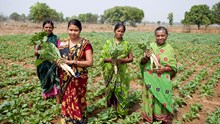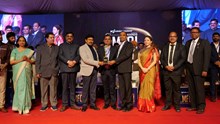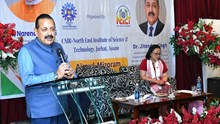
Across India's vast agricultural landscape, a quiet crisis has been unfolding for decades. The nation's smallholder farmers, the backbone of its food security, face a systemic vulnerability driven by a confluence of challenges. Many struggles with shrinking landholdings and an increasing dependence on external market forces. The costs of essential inputs from chemical fertilizers to fuel are rising relentlessly, eroding farm profits and making livelihoods precarious. All the while, valuable on-farm resources, such as livestock waste and crop residues, often go untapped, representing a significant missed opportunity for self-sufficiency and growth.
It was against this backdrop of persistent challenges that a simple yet profound question was posed in 2010 by the Agriliv Research Foundation (ARF): "Can smallholder farms become self-sufficient and profitable while remaining sustainable?" As a Scientific and Industrial Research Organization (SIRO) recognized by the Department of Scientific and Industrial Research (DSIR), the ARF was uniquely positioned to seek a solution. The answer it developed was not a new chemical or a high-tech machine but an integrated framework that leverages what is already available. This pioneering approach, known as the 5F Model, was first tested as an experiment in the village of Chidana, Sonipat, Haryana, where it would grow from a simple concept into a powerful blueprint for rural prosperity.
Blueprint for Prosperity: Unpacking the 5F Model
The foundational philosophy of the 5F Model is rooted in the principles of a circular economy. It is an integrated livelihood framework designed to create a closed-loop system, where the output of one activity becomes the vital input for another, effectively turning waste into wealth and establishing a self-reinforcing cycle of production and value. The model is built upon five interconnected pillars:
Farm, Food, Fodder, Fuel, and Fertilizer
The synergistic relationship between these components is what allows the system to minimize external dependencies and maximize on-farm value.
The Chidana Centre, established as a "living laboratory," served as the proving ground where this concept was meticulously tested and refined over a 15-year period. A pilot unit was set up to demonstrate the model's viability on a small scale, consisting of 10 dairy cows, 6 acres of cultivable land, an 85 m³ biogas plant, and a vermicomposting system. The cyclical flow of resources at the center operates in a cascading sequence:
-
The cycle begins with the dairy operation, where cattle dung is collected and fed into the biogas plant, generating clean Fuel for household energy.
-
The leftover slurry from the biogas production is then processed into nutrient-rich vermicompost, creating a potent organic Fertilizer.
-
This high-quality vermicompost is used to enrich the soil of the Farm, improving fertility and crop yields.
-
The farm, in turn, produces a portion of the green Fodder for the dairy cattle, along with crop residues that are also used for feed.
-
Finally, the dairy provides milk and dung, which not only contribute to household nutrition (Food) but also generate income and restart the entire closed-loop system.

This holistic approach reveals a sophisticated strategy that transcends a simple linear production model. The framework is not merely a collection of farming activities but a strategic integration of resources. The economic value generated is a direct consequence of this integrated, circular system. For example, by producing its own organic fertilizer from biogas slurry, the farm reduces its dependence on costly chemical inputs, while the use of biogas for fuel cuts down on expenses for monthly LPG cylinders. The financial gains and cost savings are not separate from the environmental and sustainable practices; they are a direct result of them. The model, therefore, creates a powerful "double bottom line" for the farmer, making a livelihood that is both profitable and intrinsically sustainable.
Economics of Resilience: Rs 21 Lakh Showcase
The most compelling evidence of the 5F Model's success is its proven ability to generate substantial economic value for smallholder families. The pilot unit at the Chidana Centre, through its integrated operation, demonstrated a combined annual income and savings of approximately Rs 21 lakh. This figure stands as tangible proof that a small-scale, diversified farming operation can be transformed from a high-risk venture into a high-yield enterprise.
The total value is not derived from a single activity but from the synergy of all five components. The following financial breakdown highlights the contribution of each pillar:

Total Annual Value (Income + Savings): ~Rs 21,00,000
Note:
The ARF biogas plant is of 85 m³ capacity, designed for mass production of vermicompost through purchased cow dung for full-capacity running. Electricity is also generated from the unit, but calculations here are based only on existing cows; electricity has not been compared, as small-scale replication is not viable.
A closer examination of this data reveals that the 5F Model is a powerful risk mitigation strategy for the farmer. The initial problem statement highlighted rising input costs as a major point of vulnerability. The financial data from Chidana directly addresses this issue by showcasing significant value from savings on essential inputs.
For instance, the cultivation of green fodder saves Rs 2 lakh that would otherwise be spent on purchasing feed, while the in-house production of biogas and vermicompost saves Rs 44,000 and Rs 1.2 lakh, respectively. This strategic cost avoidance makes the farm's financial health less susceptible to external market fluctuations and price shocks. By internalizing these costs, the model does not just promise higher income; it builds financial resilience and stability, a non-obvious yet critically important element for the farming community.
From Proof to Practice: Multiplier Effect
The ARF's vision for the 5F Model extended beyond a single successful pilot. The Chidana Centre was intentionally transformed from a "living laboratory" into a "demonstration hub and training centre" to disseminate the proven blueprint to a wider audience. This capacity-building effort is where the model's impact truly began to multiply. Between 2015 and 2025, over 1,500 farmers from Sonipat and surrounding districts received practical, hands-on training at the center.
The training curriculum was designed to be as comprehensive as the model itself, covering a range of practical, income-generating skills. Farmers were trained in:
-
Multilayer farming and vegetable cultivation.
-
Cow rearing with balanced feed practices.
-
Biogas plant operation and slurry management.
-
Vermicompost production and organic input preparation.


Beyond the direct training of farmers, the ARF’s approach also focused on building a supporting ecosystem within the local communities. The center engaged Women's Self-Help Groups (SHGs) in compost enterprises, creating new micro-business opportunities. Critically, the model also addressed the challenge of rural-to-urban migration by training youth as service providers in animal health, agribusiness, and enterprise management. By equipping young people with viable, skilled, and entrepreneurial opportunities, the program provided a strong incentive for local skill retention, proving that a prosperous future does not require leaving the village. The foundation is not simply transferring a farming technology; it is actively cultivating the skilled labor, businesses, and economic infrastructure needed to support and sustain the 5F Model on a community-wide scale.
Lessons of Sustainability and Scalability
The 15-year case study of the ARF Chidana Centre yields a collection of powerful lessons that extend far beyond the farm gate. The documented impacts confirm that integrated farming, when structured as the 5F Model, can deliver a truly holistic transformation for rural communities. The key takeaways are:
-
Economic Gains: Farmers adopting the model have demonstrated significant annual income and savings, ranging from Rs 10 lakh to Rs 21 lakh, depending on the scale of their operation.
-
Resource Efficiency: The closed-loop system of waste-to-energy and waste-to-fertilizer cycles has proven its ability to minimize dependency on external and often volatile markets.
-
Environmental Benefits: The model has contributed to a tangible reduction in the use of chemical fertilizers, a decrease in CO2 emissions through the substitution of LPG with biogas, and a measurable improvement in soil fertility.
-
Social Empowerment: The program has fostered new opportunities for women and youth, empowering them to create compost enterprises and agri-service businesses, thereby strengthening the social fabric of the community.
Perhaps the most significant finding from the Chidana experiment is its remarkable scalability. The document explicitly notes that the model works effectively on both 6-acre farms and smaller, more common 2-acre marginal farms, proving its adaptability to a wide range of operational scales. This is a game-changing revelation, as marginal farms represent the overwhelming majority of agricultural operations in India. A solution that only works on larger, resource-rich farms would have a limited impact. The fact that the ARF's model is a viable solution for the most vulnerable and largest segment of the farming community is what elevates it from a successful case study to a bona fide blueprint for nationwide rural prosperity.


Conclusion: A Blueprint for India's Agricultural Future
The Agriliv Research Foundation's Chidana Centre (2010–2025) is more than a farm; it is a powerful proof of concept for a new way of thinking about agriculture. The 5F Model demonstrates that integrated farming systems can be a transformative force, providing high incomes, economic resilience, and environmental sustainability for smallholder families. By re-establishing the natural cycle between land, livestock, and people, the model turns the very elements once considered waste into the foundational pillars of wealth.
The model's success is not static; it is multiplying with every trained farmer carrying the blueprint back to their village, adapting it to their scale, and sustaining rural prosperity. The 5F Model stands as a powerful testament to the idea that by harmonizing traditional wisdom with modern scientific research, India can forge a prosperous and sustainable future for its rural communities.













Share your comments